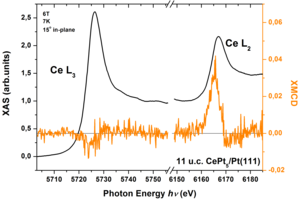P7
Local magnetic moments and their interaction in correlated systems in reduced dimensions

K. Fauth
The primary focus of this project is the experimental study of local magnetic moments and their interactions in low-dimensional, correlated systems at surfaces and interfaces. X-ray (magnetic) dichroism is a most convenient and inherently element specific probe of local moments in such ultrathin samples since its limited probing depth matches the relevant length scales . Using XMCD, we address the intricate magnetic properties of Kondo lattices and heavy fermions by specifically observing the localized part of the correlated electron system. In the preceding period, we have largely established the methodology of disentangling the complex interplay of the key parameters which determine the many body magnetic response using magnetic x-ray spectroscopy.
In any given system these include local crystal field symmetry and resulting electronic ground configuration, impurity Kondo temperature and temperature dependent valence as well as the magnitudes of the effective, partially screened paramagnetic moments and their mutual magnetic coupling. On this basis we shall now systematically extend the XMCD analysis to lower temperatures, entering the coherence regime.
Besides the paramagnetic heavy fermion state a transition towards magnetic order can occur, in which case ordering of either screened or unscreened moments is possible on theoretical grounds. Here, we expect XMCD to provide direct evidence about the particular scenario obeyed by the local moments in the systems that shall be investigated - most conveniently in instances of paramagnetic and ferromagnetic ground states.
These investigations will be conducted on ordered surface alloys, prepared on single crystalline substrates. Using the alloy thickness as an additional parameter we can identify modified behavior right at the alloy surface and attempt to explore the limit of two-dimensional Kondo lattices. Introducing heavy elements wich provide large spin orbit coupling may induce both, an enhanced Kondo effect and an increased tendency towards (ferro-) magnetic order. We shall therefore extend our studies to ternary heavy fermion compounds to explore the consequences of enhanced spin orbit interaction and associated Rashba splitting at surfaces resp. interfaces.
In collaboration with project P4, we shall additionally use XMCD techniques to characterize magnetic interface properties of oxide heterostructures. We shall particularly take advantage of most recent developments in scanning x-ray microscopy (SXM). The lateral resolution in SXM (routinely < 30 nm) will be used to map out spatial variations of spectral features representing, e.g., magnetization density distributions. Phenomena such as the coexistence of superconductivity and ferromagnetism, reported for the LAO/STO interface could thus be tested for the occurrence of spatial phase separation and the associated length scales. Yet another opportunity provided by spectroscopy within a SXM is to enhance the sensitivity with respect to the interface through lateral access in fractured specimens.

